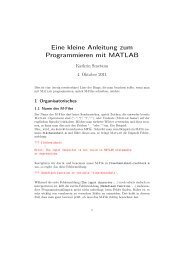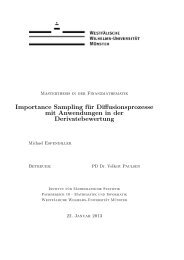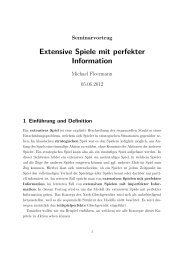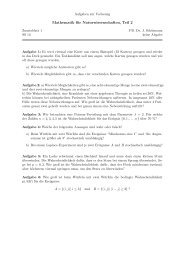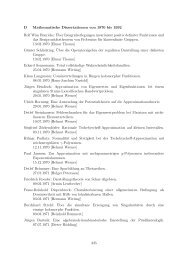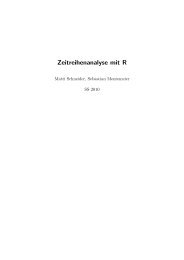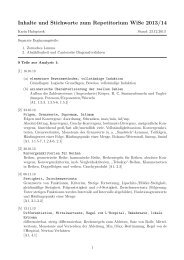Margulis Lemma
Margulis Lemma
Margulis Lemma
You also want an ePaper? Increase the reach of your titles
YUMPU automatically turns print PDFs into web optimized ePapers that Google loves.
STRUCTURE OF FUNDAMENTAL GROUPS 15<br />
where we used that the differential of f i at q ∈ B r (q i ) ′ has a bilipschitz constant<br />
e Cεi and that the ratio of vol(B 2r (f i (q))) and vol(B r (q)) is for large i bounded by<br />
a universal constant.<br />
We are left with the case of r ∈ [1/2, 1]. By <strong>Lemma</strong> 3.2, f i and g i converge in the<br />
weakly measured sense to isometries. Clearly this implies that f i ◦ g i also converges<br />
in the weakly measured sense to an isometry. And this implies that the distortion<br />
function dt fi◦gi<br />
1 has averaged L 1 norm ≤ δ i on every unit ball in B ρi (p i ) for some<br />
ρ i → ∞ and δ i → 0.<br />
□<br />
The next lemma explains the notion zooming in property.<br />
<strong>Lemma</strong> 3.5. Let (M i , p 1 i ), (N i, p 2 i ) and f i be as above. Then there is a ρ i → ∞,<br />
δ i → 0 and Ti<br />
1 ⊂ B ρi (p 1 i ) such that the following holds<br />
• vol(B 1 (q) ∩ Ti 1) ≥ (1 − δ i) vol(B 1 (q)) for all q ∈ B ρi/2(p 1 i ).<br />
• For any sequence of real numbers λ i → ∞ and any sequence q i ∈ Ti<br />
1<br />
f i : (λ i M i , q i ) → (λ i N i , f i (q i ))<br />
has the zooming in property. We say that f i is good on all scales at q i .<br />
Proof. Let G j i = B 2r i<br />
(p j i )′ and B j i = B 2r i<br />
(p i ) \ B 2ri (p j i )′ . After adjusting r i → ∞<br />
and ε i → 0 we may assume vol(B j i ) ≤ ε i vol(B 1 (q)) for all q ∈ B 2ri (p j i ). Let χ ij<br />
be the characteristic function of B j i . By the weak 1-1 inequality there exists a<br />
universal C such that the set<br />
H j i := { x ∈ B ri/2(p j i ) | Mx(χ ij) ≥ √ }<br />
ε i<br />
satisfies<br />
vol(H j i ) ≤ C√ ε i vol(B 1 (q))<br />
for all q ∈ B 2ri (p j i ). We put T i 1 := ( ) ( )<br />
B ri/2(p 1 i )\H1 i ∩ f<br />
−1<br />
i Bri/2(p 2 i )\H2 i and<br />
Ti<br />
2 := f i (Ti 1). Using <strong>Lemma</strong> 3.2 we can find ρ i → ∞ and δ i → 0 such that<br />
vol ( B ρi (p j i ) \ T j )<br />
i ≤ δi vol(B 1 (q)) for all q ∈ B ri (p j i ), j = 1, 2.<br />
By definition of T j i<br />
vol(B r (q) ∩ G j i )<br />
vol(B r (q))<br />
≥ 1 − √ ε i for all q ∈ T j i and all r ≤ 1, j = 1, 2.<br />
Let dt λif<br />
r<br />
denote the distortion on scale r of f i : λ i M i → λ i N i . Clearly<br />
dt λif<br />
r (p, q) = λ i dt fi<br />
r/λ i<br />
(p, q).<br />
Thus for all λ i → ∞ and all q i ∈ T j i<br />
the zooming in property.<br />
the map f i : (λ i M i , q i ) → (λ i N i , f i (q i )) has<br />
□<br />
Proposition 3.6 (First main example). Let α > 1. Consider a sequence of manifolds<br />
(M i , p i ) with a fixed lower Ricci curvature bound and a sequence of time<br />
dependent vector fields Xi<br />
t (piecewise constant in time) with compact support. Let<br />
c i : [0, 1] → B ri (p i ) be an integral curve of Xi t with c i(0) = p i




